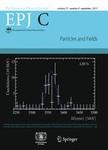版权所有:内蒙古大学图书馆 技术提供:维普资讯• 智图
内蒙古自治区呼和浩特市赛罕区大学西街235号 邮编: 010021

作者机构: Sagara Odisha Sambalpur768224 India Department of Mathematics Indian Institute of Engineering Science and Technology Howrah Shibpur711 103 India Department of Applied Mathematics Delhi Technological University Delhi110042 India Department of Mathematics Shyamlal College University of Delhi Delhi110032 India New Uzbekistan University Mustaqillik Ave. 54 Tashkent100007 Uzbekistan Central Asian University Milliy Bog’ Street 264 Tashkent111221 Uzbekistan Faculty of Computer Engineering Tashkent University of Applied Sciences Gavhar Str. 1 Tashkent100149 Uzbekistan Institute of Theoretical Physics National University of Uzbekistan Tashkent100174 Uzbekistan Department of Physics Zhejiang Normal University Jinhua321004 China Zhejiang Institute of Photoelectronics and Zhejiang Institute for Advanced Light Source Zhejiang Normal University Zhejiang Jinhua321004 China
出 版 物:《European Physical Journal C》 (Eur. Phys. J. C)
年 卷 期:2023年第83卷第11期
页 面:995页
核心收录:
学科分类:070802[理学-空间物理学] 07[理学] 0708[理学-地球物理学] 0813[工学-建筑学] 0814[工学-土木工程] 0702[理学-物理学]
基 金:NUM would like to thank CSIR Govt. of India for providing Senior Research Fellowship (No. 08/003(0141))/2020-EMR-I). This research is partly supported by Research Grants FZ-20200929344 and F-FA-2021-510 of the Uzbekistan Ministry for Innovative Development. G. Mustafa is very thankful to Prof. Gao Xianlong from the Department of Physics Zhejiang Normal University for his kind support and help during this research. Further G. Mustafa acknowledges Grant no. ZC304022919 to support his Postdoctoral Fellowship at Zhejiang Normal University.NUM would like to thank CSIR Govt. of India for providing Senior Research Fellowship (No. 08/003(0141))/2020-EMR-I). This research is partly supported by Research Grants FZ-20200929344 and F-FA-2021-510 of the Uzbekistan Ministry for Innovative Development. G. Mustafa is very thankful to Prof. Gao Xianlong from the Department of Physics Zhejiang Normal University for his kind support and help during this research. Further G. Mustafa acknowledges Grant no. ZC304022919 to support his Postdoctoral Fellowship at Zhejiang Normal University
摘 要:The current manuscript deals with the tidal force effects, geodesic deviation, and shadow constraints of the Schwarzschild-like black hole theorised in Starobinsky–Bel-Robinson gravity exhibiting M-theory compactification. In the current analysis, we explore the radial and angular tidal force effects on a radially in-falling particle by the central black hole, which is located in this spacetime. We also numerically solve the geodesic deviation equation and study the variation of the geodesic separation vector with the radial coordinate for two nearby geodesics using suitable initial conditions. All the obtained results are tested for Sag A* and M87* by constraining the value of the stringy gravity parameter β using the shadow data from the event horizon telescope observations. All the results are compared with Schwarzschild black hole spacetime. In our study, we found that both the radial and angular tidal forces experienced by a particle switch their initial behaviour and turn compressive and stretching, respectively, before reaching the event horizon. The geodesic deviation shows an oscillating trend as well for the chosen initial condition. For the constrained value of β , we see that the spacetime geometry generated by Sag A* and M87* is effectively same for both Schwarzschild and Starobinsky–Bel-Robinson black hole. Furthermore, we also calculated the angular diameter of the shadow in Starobinsky–Bel-Robinson black hole and compared with the Schwarzschild black hole. It is observed that the angular diameter of shadow for M87* and Sgr A* in Starobinsky–Bel-Robinson black hole is smaller than the Schwarzschild black hole. The calculated results satisfy the event horizon telescope observational constraints. © 2023, The Author(s).